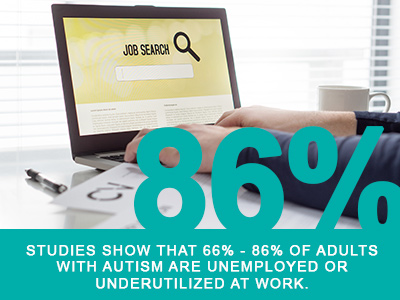
By Keisha Ward, courtesy SBAM Approved Partner ASE
In an article published in November 2018, we discussed Go-With-Your-Gut Hiring. To take this idea a step further ask yourself: Do you make hiring decisions based on a firm handshake? Have you ever changed your mind on a candidate due to noticeable “nervousness” or discomfort in the interview? Has lack of eye contact or stumbling over words ever raised a red flag? If you answered yes to any of these questions, chances are you have made a first impression, biased hiring decision – potentially costing yourself and your organization a winning candidate with autism.
Autism Spectrum Disorder (ASD) is defined as a developmental disorder of variable severity. It is characterized by difficulty in social interaction and communication and restricted or repetitive patterns of thought and behavior.
Many with ASD are highly intelligent and offer valuable skills. High functioning autistic adults are often dependable, focused, detail-oriented, and passionate about their work. Many have outstanding technical and/or math skills. They are often able to resolve complex problems. Albert Einstein is a notable example of the capabilities a person with autism could possess. Another example from history is Benjamin Banneker, an African American almanac author. Bill Gates and Steve Jobs are also a part of this group.
People with autism have difficulty with verbal and non-verbal communication. They may not fully understand or accurately interpret:
- Spoken language
- Gestures
- Eye contact
- Facial expressions
- Tone of voice
- Expressions not meant to be taken literally
They may also have difficulty with:
- Recognizing emotions and intentions in others
- Recognizing one’s own emotions
- Expressing emotions
- Seeking emotional comfort from others
- Feeling overwhelmed in social situations
- Taking turns in conversation
- Gauging personal space
You will likely notice behaviors that include repetitive body movements such as rocking. They are likely to stack or line up objects and will prefer strict routines with limited to no change.
Based on the list of notable individuals with autism, it is easy to see that despite their challenges, they have the potential to excel in many areas. However, they will likely do well in roles that do not require consistent social interaction.
An individual with these challenges would likely not give a stellar first impression in an interview setting. Studies show that 66% – 86% of adults with autism are unemployed or underutilized at work. Employment is scarce for adults on the spectrum. However, due to increased awareness this issue is beginning to show improvement. Major corporations such as Walgreen’s, Home Depot, Ford, and Microsoft have implemented programs to improve their hiring practices and increase hires. For more examples, see the 2017 EPTW article, More Companies Hiring Employees with Autism Spectrum Disorder.
Hireautism.com suggests we modify the interviewing process:
- Give candidates a detailed outline of what the interview will involve, including a list of interview questions.
- To gather information, be prepared to reword questions.
- Consider creating an alternate method to assess the candidate’s capabilities and fit for the job, such as a working interview.
- Ask more open-ended questions.
As we improve our knowledge and awareness surrounding autism, companies are beginning to understand the contributions that adults with autism provide in the workplace. Organizations such as Autism Speaks can help companies understand the benefits and provide solutions for potential challenges. In Michigan, the Autism Alliance in Michigan has worked with a number of organizations to successfully onboard autistic workers.